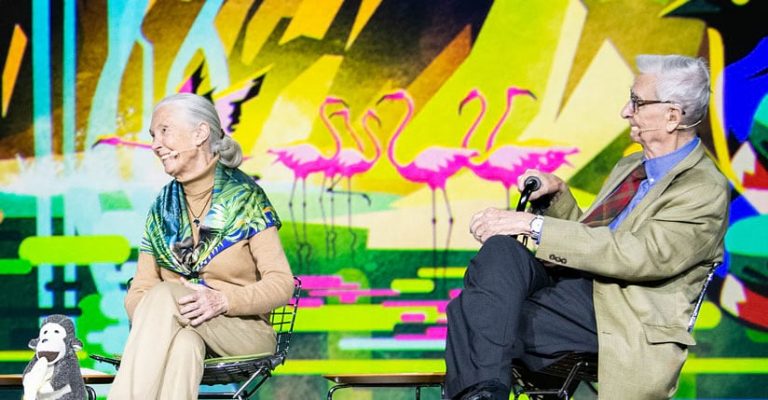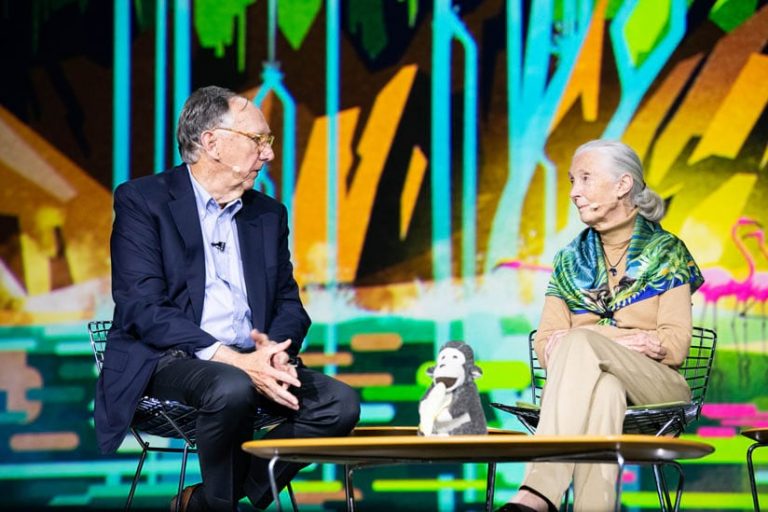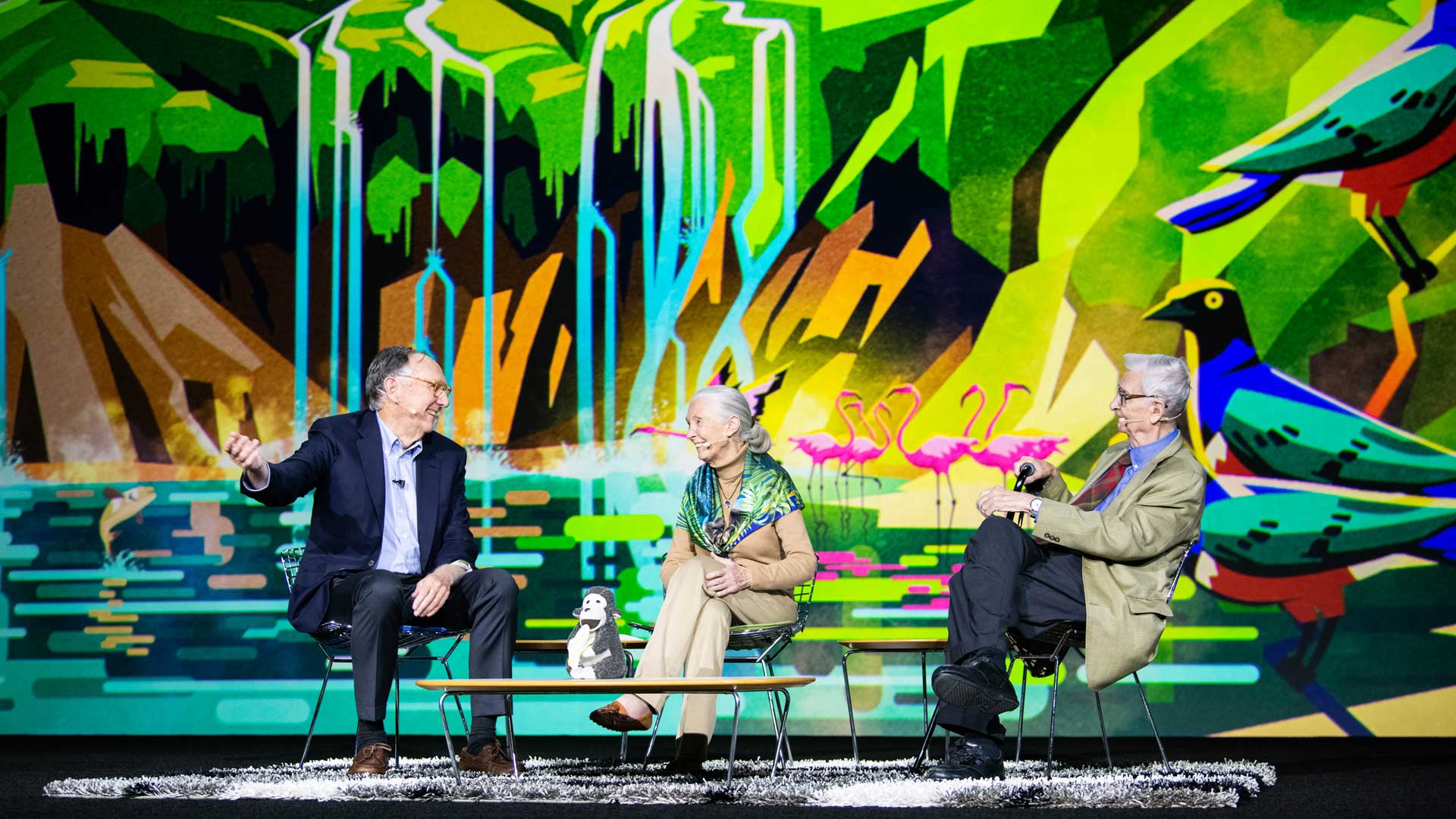Jane Goodall and Edward O. Wilson Offer Their Ideas on How to Protect Biodiversity
Though Edward O. Wilson and Jane Goodall spent nearly a lifetime studying two very different species, they have strong and similar opinions on the importance of protecting biodiversity.
Esri president Jack Dangermond brought Goodall, DBE, and founder of the Jane Goodall Institute (JGI), and Wilson, honorary curator in entomology and university research professor emeritus at Harvard University, together at the 2019 Esri User Conference for a conversation centered around biodiversity conservation.
Goodall spent decades studying chimpanzees and Wilson specialized in myrmecology—the study of ants—for more than 60 years.
One subject both Goodall and Wilson are highly interested in and concerned about, as more species go extinct, is the protection of biodiversity. Wilson, for example, through his E.O. Wilson Biodiversity Foundation, supports the Half-Earth Project. The project’s goal is conserving half the earth’s lands and seas in order to protect 85 percent or more of the planet’s biodiversity.
“I think we need to step up the [size of the] area we put aside explicitly as reserves in the parts of the earth where it matters the most,” Wilson told Dangermond. “We could get higher than 85 percent if we could do that skillfully.”

Wilson also encouraged young people to get involved in science-related careers that would give them the opportunity to identify and study the planet’s yet-to-be-discovered plant and animal species, which he estimated to number at about 10 million.
“One of the things that we must do—much more effectively than we have been—is explore the living world,” he said. “[We need] to identify, to characterize, and then love and protect most of the species in the world that, in fact, we have neglected to this point.”
Mapping all these species is necessary to better understand every plant and animal that’s out there somewhere. “We want to map biodiversity all the way around the world,” Wilson said, “and the key is to discover all the species in the world.”
Goodall said she’s optimistic about biodiversity conservation even in the face of issues such as climate change, population growth, and loss of habitat. Much of her optimism centers around youths. These include the young people involved in her Roots & Shoots program, who take on projects such as studying invasive species, biodiversity loss, climate change, and habitat destruction.
Humans share 98.6 percent of DNA with chimpanzees, Goodall said, but the two species have a vast difference in intellect. However, according to Goodall, humans haven’t always been very wise when it comes to properly protecting earth.
“When you think of the brilliant minds out there—we’ve sent a rocket up to Mars with a little robot that crept off, taking photographs,” she said. “I don’t think we want to live on Mars, having seen those photographs. We’ve just got this one blue and green planet. So how is it that the most intellectual species on the planet is destroying its only home? We do have the intellect, if we get together now, to find ways to deal with the terrible crises that we are in.”

The JDI’s Lake Tanganyika Catchment Reforestation and Education (TACARE) project in Tanzania, Africa, is on the front line of protecting biodiversity. Goodall started the project after realizing that, in order to protect chimpanzees and reverse problems such as deforestation, something needed to be done to lift the people living around Gombe National Park.
“That’s when it hit me,” she said. “If we don’t do something to improve the lives of these people, then we can’t even try to save the chimps,” she said. TACARE works with communities to promote sustainable agriculture and economic development, reforestation, and health and educational programs.
Nature can be resilient too, according to Goodall. “Give nature a chance and life can come back where we have destroyed it before, even if it isn’t exactly the same,” she said.
Wilson said there are amazing things that await discovery, and no species—including the tiniest insects—should be ignored.
“I would like to see [us] find out something about every one of these species, large and small, that has allowed them to maintain their existence for millions of years—enough so they can live on for millions of years into the future,” Wilson said. “And in so doing, [we will] gain a mastery of our own environment.”
Living on Mars isn’t the answer, according to Wilson, who has traveled to many parts of the world in his quest to study ant species. “We live in a living environment. We don’t live on the moon. We aren’t ready to go to Mars,” he said. “We live on what may be—I think almost certainly is—the only life-bearing planet in the solar system.”
Goodall nodded in agreement. “So,” she said, “we better stop destroying it.”
Watch the entire talk, The Importance of Biodiversity Conservation at a Global Scale.

